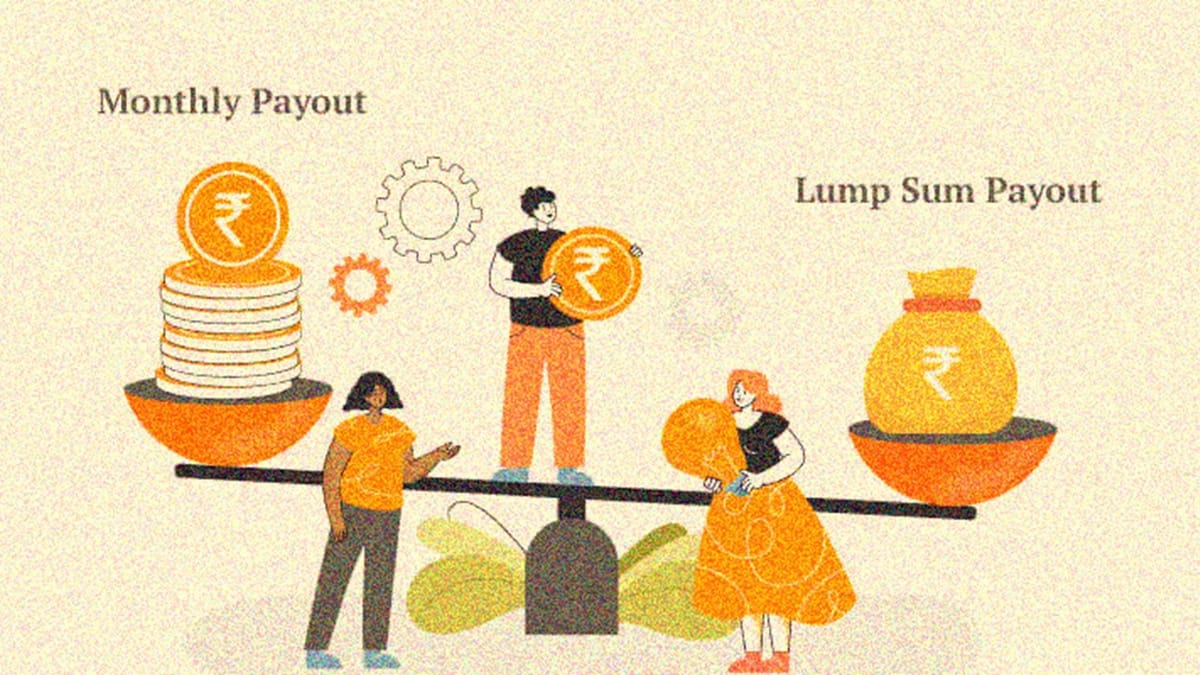Deepshikha | Jul 24, 2022 |

Lump sum or regular income? What’s better for your term policy payout?
The least expensive method of protecting one’s family financially is with term policies. When an earning member passes away, their dependents receive a death benefit that aids in meeting their financial obligations.
In the event of a claim, insurers typically offer the insured the choice of how their family members would be compensated.
Let’s understand the different payout options available under the term plan.
In this situation, upon the death of the policyholder, the nominee receives a 100% lump sum payment equal to the sum assured. For instance, if someone were to buy a life insurance policy for Rs 1 crore and choose a one-time payout, the entire Rs 1 crore would be paid to the nominee upon the policyholder’s passing.
In this case, there is no lump sum payment made to the beneficiary following the death of the insured. Instead, customers receive the amount insured in equal monthly payments over a predetermined period (say 10-15 years). For instance, a fixed monthly payout for a sum assured worth Rs 1 crore is Rs 83,333 per month over 10 years.
Additionally, some insurers offer the option of increasing the monthly amount. For instance, it can be a payment of Rs 50,000 per month for the first year, Rs 55,000 (110% of Rs 50,000) for the next year, and so on.
In a mixed payout, the beneficiary has the choice of receiving some of the money all at once and the remainder over time. Let’s say you choose a 50:50 mixed payout with a Rs 1 crore sum assured. In the event of a claim, Rs 50 lakh would be given to the beneficiary, and the remaining Rs 41,667 will be given as monthly compensation over 10 years. Again, you might be given the option to choose a monthly payment increase of 10% every year.
According to an online quote from a top insurer, a 30-year-old male who wants a Rs 1 crore term cover up to the age of 60 will pay an annual premium of Rs 13,392 for the one-time payout option. Your premium drops to Rs 11,383 if you choose a fixed monthly payout.
Similar to how the premium for a mixed payout is less expensive than a single sum.
It is less expensive to choose a monthly or mixed distribution than a lump sum because the former’s payment is staggered and frequently results in no return.
For instance, choosing a 50/50 lump-sum and monthly payout entails paying a yearly premium of Rs 12,387. In the event of a claim, Rs. 50 lakh is paid in one lump sum and the remaining Rs. 50 lakh is paid over ten years in 120 equal instalments (Rs. 41,667).
Furthermore, the greatest premium is for a monthly payout that rises annually. This is due to the larger payout obligations both for the insurer and its policyholders.
The one-time payout works best if the beneficiary is financially savvy since they can invest the claim money properly and build wealth. Additionally, it aids in consolidating large debt.
However, if the beneficiary lacks financial acumen, they may find it difficult to manage the lump payment or may make mistakes. One might shield their family members from such a situation by selecting the option for a monthly income. Your monthly payout will serve as a replacement for your income and relieve your partner or parents of some of the financial responsibility for running the home.
Additionally, a yearly rise in the monthly distribution is preferable to a set payout. The former allows your family to retain their standard of living while shielding them from the inflationary wind. Even if it might not have a high cash return, it’s a wise choice.
If you have returned significant liabilities, such as a home loan, but still have minor debt and financial obligations to take care of, a mixed payout may be an option. Depending on the number of outstanding loans and the desired monthly payout, one may choose a portion of a lump sum payment. For instance, if you are okay with a monthly distribution of Rs. 50,000, choose a lump sum of 40%, or a 50% lump sum if Rs. 40,000 will do.
Make sure you purchase the appropriate amount of coverage, which depends on the time of life you are in, your financial objectives, and your bookkeeping liabilities.
If you choose a monthly payment schedule, estimate your household’s expected monthly expenses, taking into account spending on groceries, utilities, school tuition, and entertainment while accounting for inflation. Then, begin examining other compensation alternatives.
Insurance companies typically provide different products in terms of tenure and monthly payout. Make sure the tenure is long enough and the monthly compensation is adequate.
In case of any Doubt regarding Membership you can mail us at contact@studycafe.in
Join Studycafe's WhatsApp Group or Telegram Channel for Latest Updates on Government Job, Sarkari Naukri, Private Jobs, Income Tax, GST, Companies Act, Judgements and CA, CS, ICWA, and MUCH MORE!"